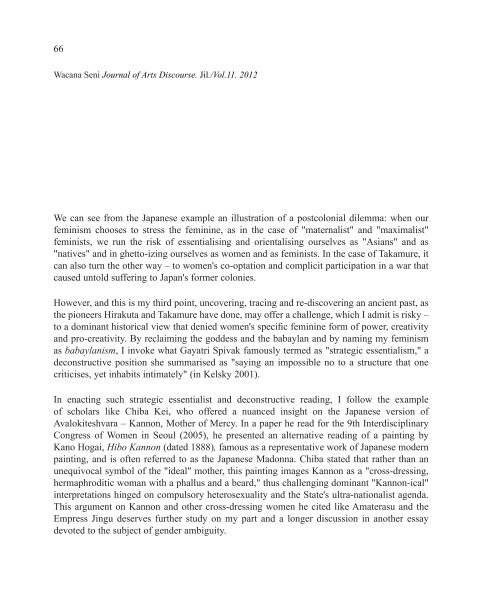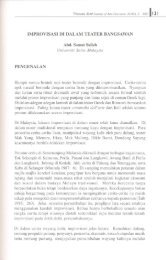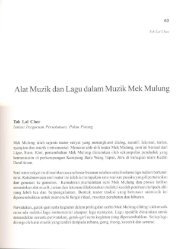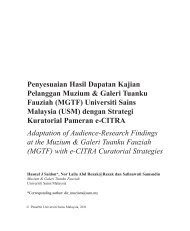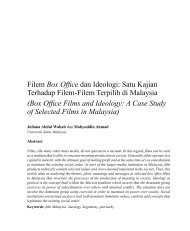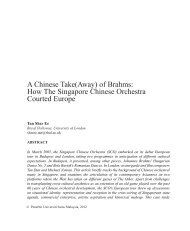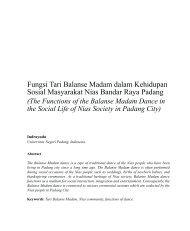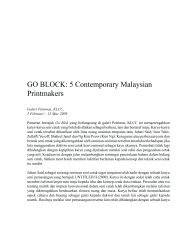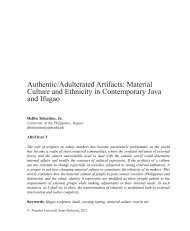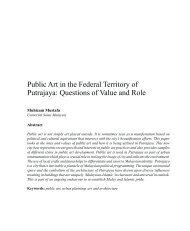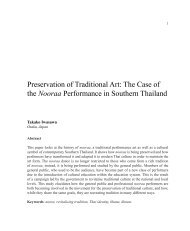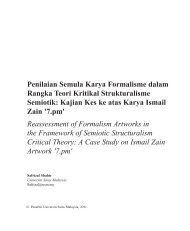Reclaiming The Healing Arts of The Ancient ... - Wacana Seni
Reclaiming The Healing Arts of The Ancient ... - Wacana Seni
Reclaiming The Healing Arts of The Ancient ... - Wacana Seni
Create successful ePaper yourself
Turn your PDF publications into a flip-book with our unique Google optimized e-Paper software.
66<strong>Wacana</strong> <strong>Seni</strong> Journal <strong>of</strong> <strong>Arts</strong> Discourse. Jil./Vol.11. 2012We can see from the Japanese example an illustration <strong>of</strong> a postcolonial dilemma: when ourfeminism chooses to stress the feminine, as in the case <strong>of</strong> "maternalist" and "maximalist"feminists, we run the risk <strong>of</strong> essentialising and orientalising ourselves as "Asians" and as"natives" and in ghetto-izing ourselves as women and as feminists. In the case <strong>of</strong> Takamure, itcan also turn the other way – to women's co-optation and complicit participation in a war thatcaused untold suffering to Japan's former colonies.However, and this is my third point, uncovering, tracing and re-discovering an ancient past, asthe pioneers Hirakuta and Takamure have done, may <strong>of</strong>fer a challenge, which I admit is risky –to a dominant historical view that denied women's specific feminine form <strong>of</strong> power, creativityand pro-creativity. By reclaiming the goddess and the babaylan and by naming my feminismas babaylanism, I invoke what Gayatri Spivak famously termed as "strategic essentialism," adeconstructive position she summarised as "saying an impossible no to a structure that onecriticises, yet inhabits intimately" (in Kelsky 2001).In enacting such strategic essentialist and deconstructive reading, I follow the example<strong>of</strong> scholars like Chiba Kei, who <strong>of</strong>fered a nuanced insight on the Japanese version <strong>of</strong>Avalokiteshvara – Kannon, Mother <strong>of</strong> Mercy. In a paper he read for the 9th InterdisciplinaryCongress <strong>of</strong> Women in Seoul (2005), he presented an alternative reading <strong>of</strong> a painting byKano Hogai, Hibo Kannon (dated 1888), famous as a representative work <strong>of</strong> Japanese modernpainting, and is <strong>of</strong>ten referred to as the Japanese Madonna. Chiba stated that rather than anunequivocal symbol <strong>of</strong> the "ideal" mother, this painting images Kannon as a "cross-dressing,hermaphroditic woman with a phallus and a beard," thus challenging dominant "Kannon-ical"interpretations hinged on compulsory heterosexuality and the State's ultra-nationalist agenda.This argument on Kannon and other cross-dressing women he cited like Amaterasu and theEmpress Jingu deserves further study on my part and a longer discussion in another essaydevoted to the subject <strong>of</strong> gender ambiguity.


